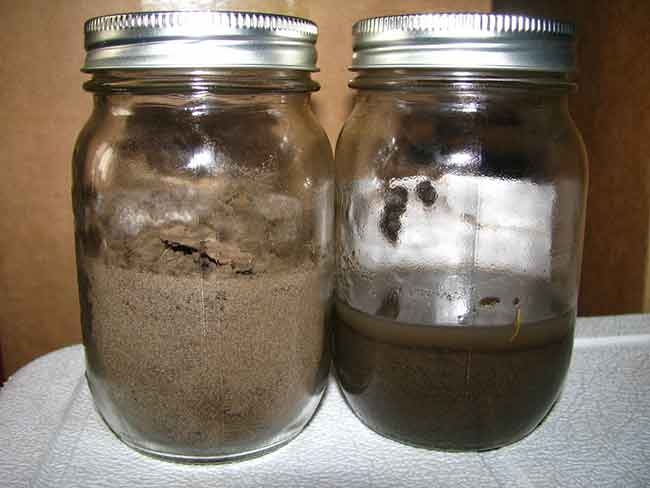
Features
Fruit
Production
Improving water quality
March 22, 2016 By Treena Hein
 Solids captured by the Geotube (left) and after 21 days of treatment. Contributed photo
Solids captured by the Geotube (left) and after 21 days of treatment. Contributed photo
The water quality around Ontario’s Holland Marsh is getting better and better, in large part due to the Holland Marsh Growers’ Association Water Project (HMGA WP).
The project is now in its third year and is funded by Environment Canada’s “Lake Simcoe Georgian Bay Clean-Up Fund.” It aims to both promote whole-farm water quality improvement and evaluate new water treatment technologies, with the focus on Lake Simcoe and Georgian Bay through the Nottawasaga Valley, Severn Sound and Lake Simcoe watersheds.
“Specifically, we are identifying levels and types of contaminants, whether they are nutrients or sediments, in discharge water from horticultural use,” says HMGA WP manager Charlie Lalonde. “We’re also testing innovative and alternative treatment technologies, and management strategies focusing on water use and treatment. Along with that comes sharing the findings with the broader horticultural industry.”
The project includes greenhouse operations and farms with field vegetables, livestock, potatoes and nursery crops. Treatment systems under evaluation are new and must be retrofitted into already-existing systems.
Agriculture and Agri-Food Canada, Environment Canada, and the Ontario Ministry of Agriculture, Food and Rural Affairs are major governance partners, contributing funding and staff time and expertise to the HMGA WP. Individual growers are contributing ideas and practical feedback, test sites and financial support. Staff at the Ontario Ministry of the Environment and Climate Change are providing advice about regulatory compliance. Research project participants include the University of Guelph, SRG Soil Research Group, McMaster and Western Universities, Flowers Canada, Farm & Food Care and the Ontario Fruit and Vegetable Growers’ Association. Companies taking part are Bishop Technologies, Newterra, Voltea, ProMinent Fluid Controls, various engineering firms (for treatment system design) and GroPak Farms.
When asked what broad lessons have become clear over the last three years, Lalonde says: “We’ve learned the first step in a wash water treatment system is most critical. Many technologies work well after a significant amount of soil has been removed, so we have to improve de-dirting of root vegetables to reduce soil load prior to washing. Muck soils are most difficult to remove from water due to particle size and particle density, so physical separation does not work.”
Lalonde believes participating growers appreciate the water project because their involvement has allowed them to address their individual situations. For other growers, Lalonde and other HMGA WP staff conduct outreach every year through workshops and other industry events. Workshop materials are also available on the HMGA WP website, along with articles, fact sheets and a blog.
“Water project staff are on grower farm sites every week to discuss treatment system options and performance,” Lalonde adds. “I think one of the most important aspects of this project is the way it has broadened the support infrastructure for the sector through introduction of new technologies, engineering firms, research partners and so on. It’s very much about continuously connecting the dots between growers and support services to make sure those offering services understand the challenges.”
The federal government is about to announce phosphorus loading targets for Lake Erie, to be met by 2018 under the bi-national “Great Lakes Water Quality Agreement.” While Lalonde notes that Lake Simcoe is its own watershed system, he sees Great Lakes’ water concerns as similar and the targets relevant.
“Growers welcome targets as they allow for better planning,” he says. “However, in each of these water bodies, the source of nutrients can be different so site-specific analysis is required.”
Lalonde believes the Great Lakes and other bodies of water such as Lake Simcoe will continue to receive lots of attention and require improvements as urban pressure intensifies.
“Although agriculture is not the major contributor to water quality, these bodies of water in both regions experience some agricultural runoff of phosphorus and nitrogen,” he says. “We are pleased that this project has produced tangible results and has created options for growers. Through continuous improvement, the environmental profile will continue to change.”
For more information on the project, visit hmgawater.ca.
Print this page